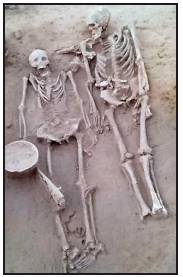Rakhigarhi
This is a collection of articles archived for the excellence of their content. |
Excavations
2019: In a first, couple found in Harappan grave
Neha Madaan, In a first, ancient couple found in Harappan grave, January 9, 2019: The Times of India

From: Neha Madaan, In a first, ancient couple found in Harappan grave, January 9, 2019: The Times of India
A rare couple’s grave — the skeletal remains of a young man and woman, interred with his face turned towards her — has been excavated at the Harappan settlement at Rakhigarhi in Haryana, about 150km from Delhi. This is the first couple’s grave that archaeologists have confirmed in a Harappan cemetery. Although many Harappan settlements and cemeteries have been investigated, no couple burials have been reported till date.
Archaeologists from Deccan College Deemed University, Pune, who are excavating the site, said the skeletons were found lying face up with arms and legs extended. They said evidence indicated the couple was buried simultaneously or about the same time. The findings were recently published in the peer-reviewed international journal, ACB Journal of Anatomy and Cell Biology.
The excavation and analysis were undertaken by the university’s department of archaeology and Institute of Forensic Science, Seoul National University College of Medicine. Vasant Shinde, one of the authors of the paper, told TOI that Indian archaeologists had often debated the meaning of joint burials. A Harappan joint burial site discovered at Lothal in the past was considered an instance of a widow’s sacrifice following her husband’s death, he said.
HARAPPAN EXCAVATION
‘Both individuals could have died at same time’
Other archaeologists said it was difficult to estimate the sexes of the individuals, and that they may not have been a couple. Other than the contentious Lothal case, none of the joint burials reported from Harappan cemeteries till date have been anthropologically confirmed to be a couple’s grave,” he said.
The manner in which the individuals were buried in the Rakhigarhi site could indicate lasting affection after death. “We can only infer, but those who buried the two individuals may have wanted to imply that the love between the two would continue even
after death,” he said. “A couple’s joint grave is not so rare in other ancient civilisations. Yet, it is strange they were not discovered in Harappan cemeteries till now,” he said.
The grave had burial pottery and a banded agate bead, probably part of a necklace.
Both skeletons were brought to the laboratory of Deccan College for analysis after field surveys were completed. Each skeleton’s sex was determined after studying the pelvic region. Their ages at the time of death has been estimated at between 21 and 35 years and the man’s height as 5 feet 6 inches and the woman’s as 5 feet 2 inches.
“It is more plausible that two individuals died at the same time or almost the same time, and were buried together in the same grave,” Shinde said.
See also
Rakhigarhi